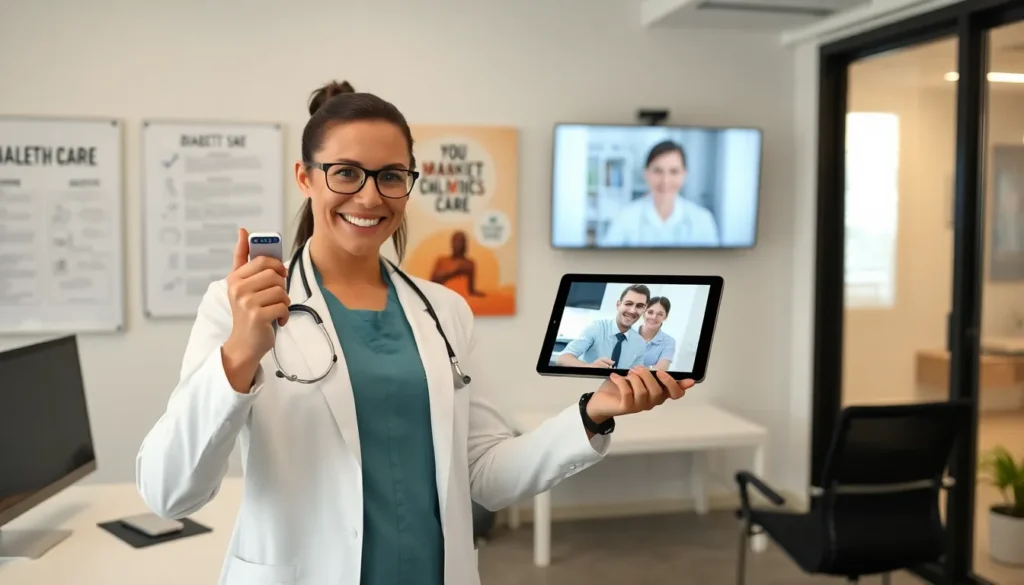Table of Contents
ToggleImagine having a personal health assistant right in your pocket, available 24/7. Well, for those managing diabetes, digital health tools are a game-changer, making life a whole lot easier (not to mention more fun.). Through mobile apps, wearables, and even virtual doctor visits, these innovative solutions are transforming diabetes care from a challenging job into a more manageable, even enjoyable, journey. This article dives into how technology is reshaping diabetes management and why you should consider embracing these tools today.
Understanding Diabetes Management

Managing diabetes isn’t just about keeping blood sugar levels in check, it’s an ongoing process that involves a balanced diet, regular exercise, and consistent monitoring. Both type 1 and type 2 diabetes present unique challenges, requiring different approaches. Those living with diabetes have to navigate a labyrinth of blood glucose readings, food choices, and medication schedules. Digital health tools aim to streamline this process, allowing individuals to take control of their diabetes management and empowering them to make informed decisions.
The Role of Technology in Diabetes Care
Technology’s role in diabetes care has evolved significantly over recent years. Gone are the days when people had to rely solely on paper logs and manual calculations. Now, technology provides accurate data and instant feedback, making diabetes management less of a burden and more of an informed experience. Devices like blood glucose meters collect data that syncs directly to apps, while telehealth solutions connect patients with medical teams without the fuss of in-person visits. The key is making diabetes management not just easier but also more effective.
Types of Digital Health Tools
Understanding the variety of digital health tools available can help individuals choose the right solutions for their needs. Let’s explore some of the most impactful options:
Mobile Applications for Diabetes Tracking
These apps assist users in recording their blood sugar levels, meals, and medications seamlessly. Some popular choices include MySugr, Glucose Buddy, and MyFitnessPal. Not only do they track important data, but many also provide personalized insights and reminders.
Continuous Glucose Monitoring Systems
CGMs are revolutionary tools that track glucose levels in real-time, allowing wearers to see their blood glucose trends without the need for frequent finger pricks. Brands like Dexcom and Medtronic lead the market in offering accurate, user-friendly devices that warn users of critically high or low glucose levels.
Telehealth and Virtual Consultations
Telehealth bridges the gap between patients and healthcare providers. Individuals can consult with endocrinologists, dietitians, and diabetes educators through video calls, making healthcare accessible regardless of location. This form of care reduces travel-related stress and ensures access to expert advice.
Wearable Devices and Their Impact
Wearable technology, such as smartwatches and fitness trackers, offers more than just counting steps. Many devices now integrate with other health apps to monitor glucose levels, physical activity, and heart rate, providing a holistic view of health. The integration of data across platforms further assists in creating tailored health strategies.
Benefits of Using Digital Health Tools
The boon of incorporating digital health tools into diabetes management is undeniable. Here are some primary benefits:
- Enhanced Monitoring: These tools provide continuous data, allowing for timely decisions and adjustments in treatment plans.
- Improved Engagement: With more visibility into their health, individuals can actively participate in their care, leading to better outcomes.
- Reduced Healthcare Costs: By preventing complications through proactive management, digital tools can significantly lower long-term healthcare expenses.
- Convenience: Accessing health information on-the-go makes it easier to adhere to treatment protocols and make informed lifestyle choices.
Challenges and Considerations
But, these tools aren’t perfect and come with their own set of challenges:
- Data Security: With increasing reliance on digital data, security concerns about personal health information are very real. Users must ensure they understand privacy policies and data encryption measures.
- Technology Barriers: Not everyone is tech-savvy. Older adults or those unfamiliar with digital tools may struggle with adopting new technologies, which can lead to issues with adherence.
- Costs of Technology: Some tools can be expensive, and not all insurance plans cover digital health devices. This can create access disparities.
The Future of Digital Health in Diabetes Management
The future of digital health in managing diabetes looks incredibly promising. As technology advances, artificial intelligence and machine learning are poised to play a larger role in predicting glucose fluctuations and personalizing treatment regimens. Future wearable devices may even be able to administer insulin automatically, taking real-time reading of blood glucose levels, almost like having a pancreas on standby. With ongoing innovations, individuals can look forward to a future where diabetes management is not just straightforward but also more integrated into their everyday lives.




